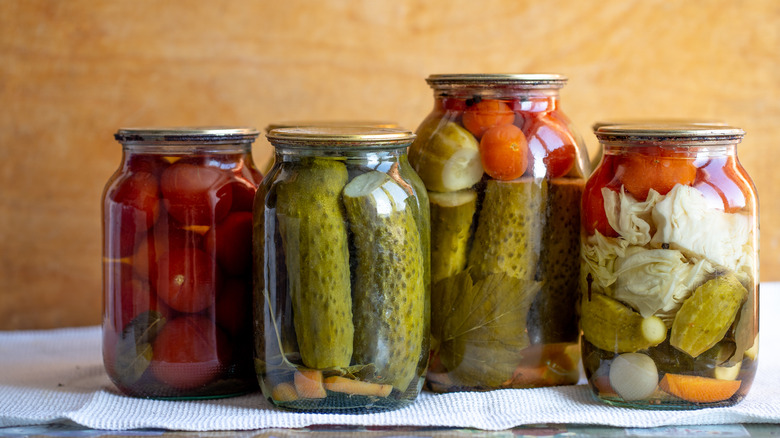
The question of whether do pickles count as a vegetable often sparks debate. While they start their life as cucumbers, which are undeniably vegetables, the fermentation process transforms them into something unique. This transformation involves vinegar, salt, and time, altering both their nutritional content and how we categorize them in the culinary world.
This article delves into the fascinating world of pickles, exploring their origins, the science behind their creation, and ultimately, whether they deserve a place on our vegetable plate. We’ll examine their nutritional profile, compare them to their cucumber counterparts, and consider their role in various cuisines.
What Are Pickles?
Pickles are cucumbers that have undergone a preservation process known as fermentation. This involves submerging the cucumbers in a brine solution, typically composed of vinegar, salt, and sometimes spices. The fermentation process is driven by beneficial bacteria called lactic acid bacteria (LAB), which convert sugars in the cucumbers into lactic acid. This acidification creates an environment hostile to harmful bacteria, effectively preserving the pickles and extending their shelf life.
There are various types of pickles, each with its own unique flavor profile and preparation method. Dill pickles, perhaps the most popular variety, are characterized by their tangy flavor and dill-infused brine. Bread and butter pickles, on the other hand, feature a sweeter taste thanks to the addition of sugar and spices like mustard seed.
Pickle Varieties
Beyond dill and bread and butter, the world of pickles offers a diverse range of flavors and textures. Sour pickles are known for their intense tartness, while sweet pickles boast a more sugary profile. Gherkins, small pickled cucumbers, are often used as garnishes or snacks. Specialty pickles incorporate unique ingredients like garlic, hot peppers, or even fruit, adding further complexity to the pickle universe.
Pickle Fermentation Process
The fermentation process is crucial in transforming cucumbers into pickles and bestowing them with their characteristic tangy flavor. It begins with preparing a brine solution, typically consisting of vinegar, salt, water, and sometimes additional spices. The cucumbers are then submerged in this brine, ensuring they are fully covered.
Lactic Acid Bacteria
As the cucumbers sit in the brine, beneficial bacteria called lactic acid bacteria (LAB) begin to colonize their surface. These LAB consume sugars present in the cucumbers, producing lactic acid as a byproduct. This lactic acid lowers the pH of the brine, creating an acidic environment that inhibits the growth of harmful bacteria and preserves the pickles.
Time and Temperature
The fermentation process takes time, typically ranging from several days to several weeks, depending on factors like temperature and desired flavor intensity. During this period, the LAB continue to ferment the cucumbers, producing a complex array of flavors and aromas. The longer the fermentation, the more pronounced the tangy taste becomes.
Nutritional Profile of Pickles
While pickles are often enjoyed as a condiment or snack, they do offer some nutritional benefits. They are a good source of electrolytes like sodium and potassium, which can be helpful for hydration. Pickles also contain small amounts of vitamins and minerals, including vitamin K, vitamin C, and iron.
Sodium Content
It’s important to note that pickles are relatively high in sodium due to the salt content in the brine. Consuming large quantities of pickles can contribute to excess sodium intake, which may be a concern for individuals with high blood pressure or other health conditions.
Are Pickles Vegetables?
The question of whether do pickles count as a vegetable ultimately boils down to perspective and context.
From a botanical standpoint, cucumbers are classified as vegetables, and pickles originate from cucumbers. However, the fermentation process significantly alters their composition and culinary characteristics. Some argue that this transformation elevates pickles beyond the realm of simple vegetables, placing them in a category of their own.
Culinary Classification of Pickles
In culinary terms, pickles often occupy a unique space. They are not typically used as primary ingredients in dishes like fresh vegetables but rather serve as flavorful additions or condiments. Their tangy acidity and crunchy texture complement various cuisines and dishes, adding a burst of flavor and complexity.
Pickle Versatility
Pickles find their way into diverse culinary applications. They can be enjoyed as snacks, added to sandwiches and burgers, incorporated into salads, or used as a topping for charcuterie boards. Pickles also play a role in traditional recipes from around the world, showcasing their versatility and cultural significance.
Conclusion
The debate surrounding do pickles count as a vegetable is likely to continue, with valid arguments on both sides. While they originate from cucumbers, which are vegetables, the fermentation process undeniably transforms them into something distinct. Ultimately, whether you categorize pickles as vegetables depends on your individual perspective and culinary context. Regardless of their classification, pickles remain a beloved and versatile food enjoyed worldwide for their unique flavor and crunchy texture.
